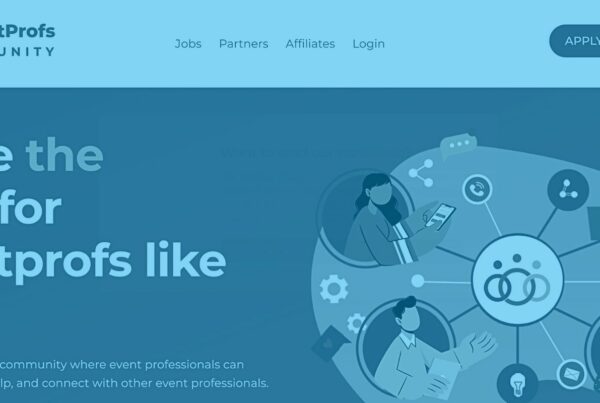As we continue to transition out of the pandemic and into 2023, the effects of economic downturn, layoffs, and budget cuts are felt across the tech industry. And with record-breaking inflation, it’s no surprise many event professionals are forced to navigate tighter budgets with rising costs. So, what should you do if you think you’re going to deal with a reduced event budget?
In this episode of the Event Tech Podcast, Will and Brandt consolidate years of advice into eight tips event professionals can take into 2023. They’ll share where they would start if forced to reduce your event budget, what and how to cut, and how the right mindset can change your perspective.
Start with Your Goals, Objectives, and Stakeholders
Before diving into the tips, Brandt takes the conversation to objectives and goals. “That’s the fastest way to figure out what I can cut,” he says. “You need to take one step back and say, why are we doing this event? What’s the purpose? So many of your questions will flow from that; the rest is knowing your stakeholders. What do attendees want to get out of it? What do your salespeople want out of it? If you start slashing your budget willy-nilly, you could accidentally cut something important, which might not be obvious to you.”
Will agrees. Knowing your stakeholders will help you make the right decisions regardless of the advice shared today. “I’ve been infamously going around talking about budgets. One of the things I’ve been saying is to get rid of catered lunches and instead give attendees a three-hour lunch. I give that advice mainly to challenge people to think differently. But if you know your stakeholders, it might not make sense for them to walk away for three hours. That’s one of those cases where my advice might not work.”
Tip #1 and #2: Don’t Just cut. Build up
Will’s first tip is to stop duplicating your budget spreadsheets. He cautions against “trying to tweak little things. At that point, it can seem hard to make big differences. We need to not just think outside the box, but crush the box. And pair that with the hard question, does this help my goal?”
Brandt loves this tip. “That’s a phenomenal first tip: don’t just start looking for places to cut. Start from zero and build it from the ground up. How would you design this show if you started from scratch without all the baggage? You might be surprised at what the potential cost savings might be.”
And as Will shares, finding a new vendor isn’t a quick fix either. “You might think all the baggage will go away, right? No,” he says. “What often happens is you’ll end up handing over something from the last year, and they copy and paste it, word for word, with zero context of what’s happening. For example, AV might have been thrown an Encore system. You’re sitting here like, why do we have this? It’s great to have this awesome piece of technology, but in reality, it’s not needed because it’s just over-scoping of what’s necessary.”
“So tip #1 is, remember why you’re doing the show in the first place,” explains Brandt. “Tip #2 is to scrape off a lot of that built-up waste.”
Tip #3: Look for Redundancies
“I have another one: next year, look for redundancies,” shares Will. “For example, there were no live captions for streaming in a platform, so we paid for automated captions. Well, then, the platform came out with automated captions for free. But because you aren’t clearing out that budget, you end up with redundancies and might be paying for the same thing twice.”
“Along the same lines, keep an eye on redundancy in consumables,” adds Brandt. “We’re talking about batteries, tape, and stuff like that. I shared my world-famous request for a proposal (RFP) back in the day. Every single breakout room had three rolls of tape, multiple nine-volt batteries, and two terabyte drives listed. We didn’t need eight brand-new rolls of tape and 36 batteries a day for one wireless microphone. So keep an eye on those consumables, where they’re listed, and how many times they’re listed.”
Will also suggests looking for redundancy in labor. “Your platform technology might have built in a lot of labor hours to help build out your conference. But if you’re using the same vendor again, there might be a chance they don’t need as much time because they understand the technology even better. This is all case by case, but you can have these conversations.”
Tip #4: Different Locations Have Different Costs
Next, Will shares a quick tip: your event’s location can dramatically affect your event’s cost. “For example, let’s say you decide next year will be in Chicago. Get ready for unions and higher costs. Even if you’re not talking about changing cities, sometimes trying to find that independent third-party venue might save you a ton.”
“Yeah, the venue’s location is another great point,” says Brandt. “So often, I would see people do a show in San Antonio, and then they’d move to Vegas the next year with the same budget. It isn’t going to work. You’re not going to get the same value you’d get from a smaller market venue.”
“I can probably name off the top of my head: San Francisco, Las Vegas, New York, Miami. That’s where you’re going to get hit hard. The costs are going to be high,” says Will. And don’t forget to factor in unions. “Those union towns are where you’ll spend a lot.”
Tip #5: Don’t be Afraid to Talk About Money
As Will reports, clients often try to save money by removing different things without clearly communicating their intentions. Instead of slashing before collaborating, he suggests communicating first.
“If you know your budget’s going to come down next year, start the conversations now,” says Will. “Some clients are too afraid to say, ‘I need my cost down to X.’ I think this transparency is important because your vendors are experts too. If you say to them, ‘Where do you think I can save money?’ They’ll note those hidden items. They might help you negotiate with the union because you’re in a union city this year. But you have to start the conversation, and you can start that early on.”
Brandt agrees with this tip. And he has examples to back it up. “I’m thinking of some of the companies I’ve worked with in Las Vegas where they said, ‘We have union people on staff. So rather than you getting them elsewhere, we’ll request this lightboard operator to come through.’ Then you’re going to get a lower rate because you’re not getting the markup.”
“Definitely,” says Will. “And these things apply to your platforms too. If you go to your platform and say, ‘I need to save $2,000, what should we do? They might give you a discount to help you get through this year, but they need the commitment that you’ll come back to X budget number next year.”
He also suggests taking on multi-year contracts to save money. “If you’re ready to commit, I’ll say this firsthand, we give multi-year contracts to people, and we give discounts and favorable pricing to those who lock-in. And what’s great about that, too, is it means you don’t have to worry about who to work with next year.”
Tip #6: Consider Competitive Bidding
Next, consider bidding services and software against each other, especially if you’ve been committed to one service or platform for several years.
“When it comes to looking at your budgets, if you haven’t reevaluated and bid stuff out in the last three years, I would bid it out,” says Will. “If you have the same pricing you had in 2020, chances are you’re paying three times more. In 2020, we had massive overpricing because demand was so high, but it’s dropped significantly.
Brandt agrees. “That’s why, in 2020, I was screaming not to get locked into a multi-year contract. I know many people did because they thought they were saving money. Go back and listen to our episode on what we would change if we had to go back and relive the last three years. If you’re stuck in multi-year contracts, it’s worth returning to your salesperson and saying, ‘This is ridiculous. You’re charging a 10th of what we locked in at. You have to give us a break on that.’ And if they want to keep you as a customer, they’ll consider it.”
Will shares an example of this tip in action at Endless. “We use Gong to do all of our call recordings. It was the greatest thing I’d ever seen when I found it. I told my friend I use Gong, and he told me about three new, cheaper competitors that had come up last year. So, you know what I did? I bid them against each other. Gong came down in cost.”
Tip #7: Try new Technology (with Caution)
If you’re tech-savvy, trying beta versions of new tech can be a great way to get the same service for less. “I’m a huge fan of trying to find the new tool that comes out,” says Will. “Often, it’s less expensive because they’re running on early VC money and trying to get their first couple of customers.”
“There’s another reason for that as well; many younger companies want to put big names on their website,” adds Brandt. “So if you’re working for a brand name organization, you might have an advantage. You can say, ‘Hey, we’ll give you permission to say you did our event if it goes well and you give us a 20% discount.’ There are lots of ways you can negotiate that.”
As you check out new software and technology, look closely at how much custom work you’ll need compared to out-of-the-box tools. “For example, you need a non-native integration for your CRM,” says Will. “They might put a developer on it to ensure it’s working. The more they need to help set it up, the more expensive it will be. But the more a tool is out of the box, the cheaper it will be.”
Highly customized software also isn’t sustainable, as Brandt points out. “At some point, you just don’t have enough developers to handle all the requests,” he says. “I’ve run into that where it was clear that everything was being done manually on the backend. We ran into problems where we couldn’t get a hold of that one person, it was busy, or it was the weekend. When you’re in the world of, ‘we’re full custom,’ it’s great, but it’s a double-edged sword.” So, proceed with caution.
Tip #8: It’s not all About Growth
For today’s final tip, Will encourages event professionals to evaluate their mindset. “A lot of times, as event planners, we’re looking to grow every year. It’s okay to say, let’s wait one more year. Let’s sustain for one year and give the same level of quality. Not necessarily because we’re going out of business, but we need to put a pause as we brace for this next year.”
“Sustaining is good,” says Brandt. “A lot of the problem with the Silicone Valley mindset is growth, growth, growth. But sustaining your membership and income through a downturn is an achievement in itself. Sometimes we need to not be so worried about grow, grow, grow, grow, grow.”
Final Thoughts
Planning events with a reduced budget is difficult, but we hope these eight tips help you through this challenging task. As always, we’d love to hear from you. Let us know what specific budget scenario you have to work through; we’d love to workshop it live on air. Send us your challenges, thoughts, or what you’d do differently. And if you’d like more tips, advice, or support, check out these episodes:
- What We Would Have Changed in Recent Years
- Layoffs and Consolidation in the Events Industry
- Data Protection in the Events Industry
We’ll see you here next time on the Event Tech podcast!








